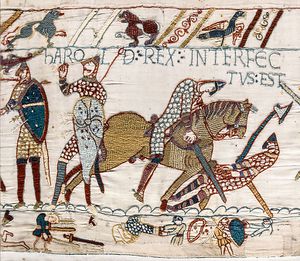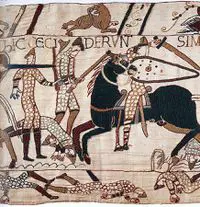Fact and fiction the Battle of Hastings (1066)?
The Battle of Hastings (1066) is perhaps the most famous battles in Medieval Britain, if not Europe. This bloody day changed the course of British history and had a profound impact on the development of the modern world. It led not only to a change of dynasty in England but also indirectly to the development of the English language, law, and political institutions which have had an immense impact, far beyond the British Isles. The battle followed in the wake of the Normans landing on the southern coast of England. King Harold II, after defeating a Viking invasion at Stamford Bridge in the north of England headed south to meet the invaders. The two sides met at Hastings in Sussex on the 16th of October 1066. The battle lasted all day and only ended with the death of Harold II. At Hastings, the Normans routed the Anglo-Saxons, and this allowed them to conquer and occupy England. The Battle of 1066 is so famous that many think they know what happened. This is not the case and there are many myths about the battle, that many people accept as historical fact. In reality, the surviving accounts of the Battle of Hastings are all suspect. They are either written by Anglo-Saxon writers who hated the Normans as foreign overlords, or they were authored by Normans who had an interest in misrepresenting events. This article will try and disentangle fact from fiction and truth from myth, with regard to the Battle of Hastings.
Reason for the Battle of Hastings
The background to Hastings was the death of Edward the Confessor, king of England from 1042-1066. He died without an heir and this as usual in the Middle Ages led to a succession crisis.[1] There were two main contenders for the crown of England; Harold Godwinson, a member of one of the most powerful Anglo-Saxon families and Duke William of Normandy, the future William the Conqueror.
William and his Normans were the descendants of Norse Vikings who had been given land in northern France and were largely independent of the French King. The Anglo-Saxon had been the brother-in-law of Edmund the Confessor. It is widely reported from sources at the time, that the dying king made Harold his heir and left his widow and Kingdom in his care. However, there is a different Norman account, and it holds that Edward the Confessor during a period of exile made Duke William his heir if he died without an heir. Historians have long debated which claim was the strongest, and most believe that Harold was the legal heir of Edward the Successor.
The story that Duke William was the legitimate successor of Edward is unlikely and was Norman propaganda. Even if Edward had made him his heir, he had almost certainly changed his mind before his death. Indeed, Harold had even been legitimately elected by the Witan the assembly of the Anglo-Saxons, and they viewed him as their rightful ruler. King Harold II was defending his realm at the battle and William the Conqueror was an invader who had no real support in the wider country. The Battle of Hastings was the result of William's naked ambitions.[2]
The reason for Harold's defeat
The Anglo-Saxons were forced to march south at speed in the wake of their victory over the Norwegian King Harald Hardrada and his Anglo-Saxon allies at the Battle of Stamford Bridge. This was a bloody clash, and the forces of Harold suffered numerous casualties even though he decisively defeated the Viking army. The victors at Stamford Bridge then had to make a forced march from the north of England to the south coast, and it is widely argued that this was a contributory factor in the Anglo-Saxon defeat.
However, not all historians agree with this, and they point out to the fact that the army of Harold fought very well during the battle. Indeed, even in the Norman accounts show the Anglo-Saxons as fighting fiercely, from early morning until the evening. Based on the distance between the two battles it would seem that the Anglo-Saxon army marched 27 miles (39 km) a day, but that they had a day’s rest before the fight.[3] Indeed, Harold was able to seize the high ground and establish a strong defensive position on the battlefield. It is not correct to state that the fact that the Anglo-Saxons were tired after their forced march and earlier battle and that this led to their defeat at the hands of the Normans.
The course of the Battle of Hastings
The heavy infantry of the English was famous, and they carried long spears and shields. Harold’s Anglo-Saxons used their traditional battle tactic of a shield-wall. They would stand side-by-side and their interlocking shields would form a solid wall. The shield-wall was very difficult to break down and it was a tactic that had been used very successful by Alfred the Great against the Vikings. The infantry of Harold II set up a shield-wall on a hill and broken ground and they were in a very strong position. This is agreed to have been the right decision.
The Normans had to inflict a defeat on the English as they were in enemy territory and had only a limited amount of supplies.[4] This meant that William the Conqueror’s army was forced to go on the offensive and it was essential that he broke the massed ranks of the heavy infantry of Harold. The Normans knew that if they broke the formation of the Anglo-Saxons that they would be victorious. From the early morning of the 18th of October, William attacked the Anglo-Saxon shield wall. The had numerical superiority in cavalry and the Norman knights were among the finest in Europe. They still failed to break the shield-wall. Then William ordered his archers to unleash volleys of arrows at the enemy’ s line. They were mostly Bretons and acknowledged to be great archers, but they could not break the English lines.
Norman and some Anglo-Saxon sources claim that the decisive moment in the battle was the feigned retreat of the Normans invaders. William ordered his men to retreat and this tempted the Anglo-Saxons to break their defensive formation and go on the offensive.[5] They left the high ground and the shield-wall was no longer intact. The Normans wheeled round and engaged the onrushing English, who were very exposed. The cavalry of William was able to inflict terrible casualties on the army of Harold II and this maneuver turned the battle decisively in favor of the Normans.[6]
The death of Harold changed the tide of battle?
In many modern accounts, the Battle of Hastings was a closely fought battle and as long as the Anglo-Saxons shield-wall held they were able to repel the Normans. It is widely reported that the death of Harold changed the tide of battle. Until his death, the battle was headed to a bloody stalemate. The sudden death of the king of England changed the course of the clash and probably altered the course of English and global history.
However, while it is known for certain that Harold was killed during the battle his death did not doom the Anglo-Saxons to defeat. [7] The last Anglo-Saxon king was killed after the tide of battle had shifted decisively in favor of the invaders from France. The feigned retreat ordered by William had worked brilliantly and his counterattack had effectively won the day. One of the greatest myths about the battle was that Harold’s death doomed the Anglo-Saxons to defeat and to their eventual domination by the Normans.
How did Harold die at the Battle
One of the apparently undisputed facts about the battle was that King Harold II was killed after he was struck by an arrow in the eye. This is based on one account and on a scene from the Bayeux Tapestry. This tapestry is a 70-foot-long (200 meters) work of embroidery that depicts the Battle of Hastings. It was created in the 1070s and is one of the most significant accounts for the events of 1066. It does show a man being hit by an arrow to the eye and this is widely believed to have been a visualization of the death of the last Anglo-Saxon king. However, there are different accounts of the death of Harold, but they all agree that he died in battle.[8]
In one Norman chronicle, the Anglo-Saxon monarch was slain as he ran away, but this was probably an invention to discredit the memory of a man still revered by many people in England for decades after 1066. There is another account of Harold’s death, that states he was hit by a number of arrows and as he lay wounded he was hacked to pieces by some foot soldiers. How Harold died on that fateful day in October 1066 will never be fully established and even the burial place of the last Anglo-Saxon king has not been identified.[9]
The end of the conquest?
In most historical accounts the Battle of Hastings is shown to be so decisive that it ended all resistance against the Norman invaders and the Normans were able to impose their will on England. The reality is more complicated, while the Battle was decisive resistance to the invaders remained. While the English nobles had submitted to William before his coronation as King in Westminster Abbey in 1066, Norman control was somewhat challenged. The Harold's repeatedly raided the coast of England from Ireland and there were sporadic revolts against William I.
In 1069 the Danes landed in northern England to support a rebellion by the Northern Anglo-Saxon Earls. The Norman king was forced to pay the Danes to leave England. When the rebels refused to do battle, William the Conqueror launched a scorched earth policy, which caused a famine. This came to be known as the Harrying of the North and some modern writers claim that it was tantamount to an act of genocide against the local population. The myth that the Battle of Hastings was the end of the conquest is not borne out by the facts. [10] Indeed it was only in 1070 with the suppression of the Northern Earls was completed.
Conclusion
There are many myths around the Battle of Hastings. Instead of being a contest for the English crown, it was an illegitimate bid for power by William who had a weak claim to the English throne. Next, Harold's army did not lose the battle because of a forced march, nor did Harold's death turn the tide of war, because he died after the Normans had taken the advantage. William's feigned retreat was brilliant that led to a decisive victory. Finally, William’s victory in 1066 did not resistance to the Norman invaders. English rebels fought for another four years before William consolidated control over England.
Further Reading
Palliser, D. M. (1993). Domesday Book and the ‘Harrying of the North'. Northern History, 29(1), 1-23.
Brown, R. Allen. The Normans and the Norman conquest (Leeds,Boydell & Brewer Ltd, 1985).
Chibnall, Marjorie. The debate on the Norman Conquest (Manchester, Manchester University Press, 1999).
Bradbury, Jim. Battle of Hastings.(London, The History Press, 2010).
References
- ↑ Lawson, M. K. The Battle of Hastings: 1066 (Stroud, UK: Tempus, 2002), p 12
- ↑ Marren, Peter. 1066: The Battles of York, Stamford Bridge & Hastings. Battleground Britain. (Barnsley, UK: Leo Cooper, 2007), p. 113
- ↑ Marren, p 201
- ↑ Morillo, Stephen. "Hastings: an unusual battle." In Medieval Warfare 1000–1300, (London, Routledge, 2017) pp. 313-321
- ↑ Bachrach, Bernard S. "The feigned retreat at Hastings." Mediaeval Studies 33 (1971): 344-347
- ↑ Morillo, p 318
- ↑ Marren, p 119
- ↑ Marren, p 118
- ↑ Rex, Peter. Harold II: The Doomed Saxon King (Stroud, UK: Tempus, 2005), p 119
- ↑ Lawson, p 118


